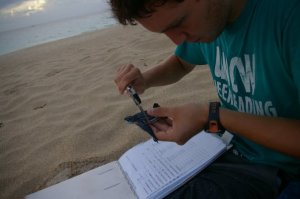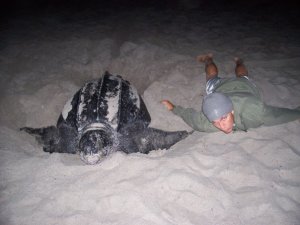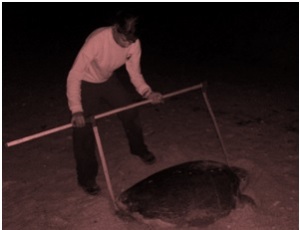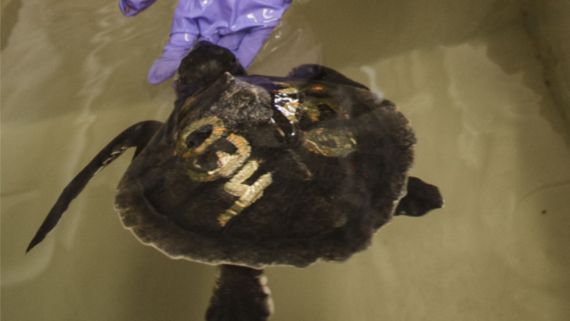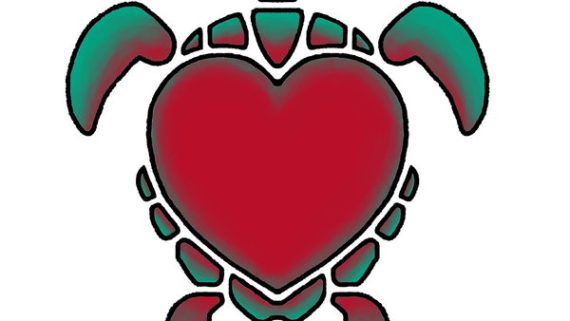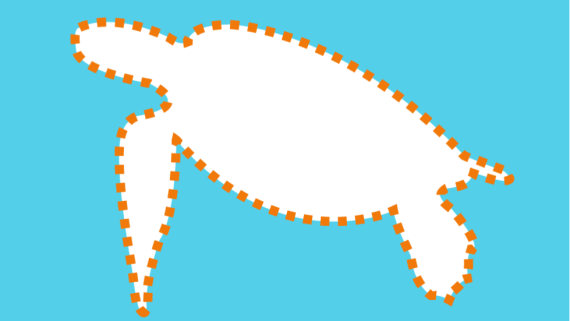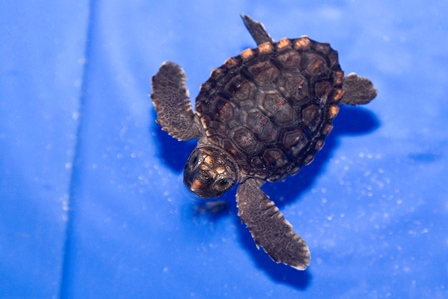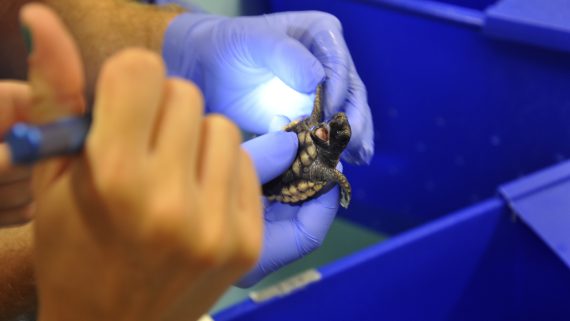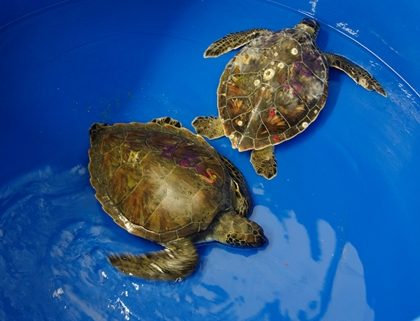Learning from Leatherbacks
This week we are meeting Justin, a sea turtle researcher who used to work here at the Aquarium.
Justin Perrault here from Mote Marine Laboratory. I am currently Mote’s head marine turtle researcher looking at the effects of contaminants and natural toxins on the health and reproductive success of nesting loggerhead sea turtles. My first experience working with marine turtles actually occurred at the North Carolina Aquarium at Fort Fisher. At the aquarium each year, we raised three loggerhead turtles from local beaches. They were then released after about a year The education staff and I had a “turtle talk” booth where we discussed fun and interesting facts about the local loggerhead turtles.
After working at the aquarium, I applied to graduate school to continue working with these amazing creatures. I moved from North Carolina to Boca Raton, Florida where I did toxicology research with endangered leatherback sea turtles. I studied two populations during my time as a PhD student: the Jupiter Beach population and the St. Croix population. Leatherbacks are truly remarkable and are probably my favorite of all of the marine turtles. They are the largest of all turtle species (weigh around 1000 lbs and are 6 feet long) and have the widest geographic range of any reptile on the planet. They can be found anywhere in the Atlantic Ocean in waters off the coast of Nova Scotia all the way south to South Africa and Argentina.
Leatherback migrations are also pretty unbelievable. Leatherbacks travel thousands of miles from their very cold foraging grounds to warmer, tropical nesting grounds fueled by their primary food source: jellyfish. It’s pretty amazing that they can travel so far by eating such energy poor prey (jellyfish are about 95% salt water). They are able to survive on jellyfish based on the quantity that they consume daily, which is about 300 kg or 660lbs of food per day.
After graduating with my doctoral degree, I was hired as a Postdoctoral Research Fellow at Mote Marine Laboratory in July of 2013. Because leatherback turtles do not nest on the western coast of Florida (where Mote is located), I decided to switch my research focus to loggerhead turtles, which nest frequently on this coast. While loggerheads are not quite as large as leatherbacks, they are still pretty cool animals. During the 2014 nesting season, we had two turtles return to lay their eggs on Sarasota’s beaches that were originally tagged in 1984 on the SAME BEACH where we observed them this year. That means that these female loggerheads have been laying eggs for at least 30 years and are probably somewhere from 55–65 years of age. We are able to identify these animals based on internal tags called PIT tags that we place in them (very similar to a microchip that you put in your cat or dog).
When I originally decided I wanted to pursue a career in research, I did not necessarily think sea turtles would be my primary research focus. However, now that I have worked with them for almost a decade, I can’t imagine working with anything else. These animals are extremely resilient.
Here I am with a smaller than average leatherback turtle. It is not a good idea to use flash photography with nesting sea turtles as it will confuse them. , We use a red light instead., It is illegal to approach marine turtles without proper permits and this photo was taken under permitted conditions.
We take measurements of all nesting loggerheads on the beach. Here a Mote Marine Laboratory intern takes a straight carapace length measurement of a nesting loggerhead turtle. This particular turtle (known as “Skittles”) at one time had a satellite tag, so we know where she travels after she leaves the nesting beach. “Skittles” remains in the western Gulf of Mexico when she is not here during the nesting season.
Learn more about Justin’s research in the video below.
Would you like a Leatherback for your classroom? Download Leatherback coloring pages here. While our Loggerheads don’t grow as big as Leatherbacks ours are still growing! This week Turtle A is 12.3 cm long and weighs 331.3 grams and Turtle B is 13.5 cm long and weigts 406.5 grams. Not sure what to do with this weight and length? Learn more in our Hatchling to Yearling lesson plan.


